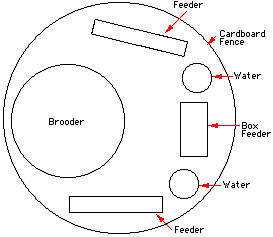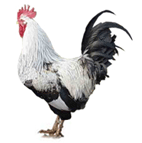|
Good layers develop from healthy, well-bred chicks raised under
good feeding and management programs. Buying the right type of
chick is important for the most economical production. The best
hens for egg production are the small-bodied commercial White
Leghorn strains with a high rate of egg production that yields a
lower production cost per dozen eggs. Some commercial brown
egg-laying strains are now available that lay nearly as well as
White Leghorns and are satisfactory for small-flock production.
Consider raising both some good egg-type pullets and some
broiler crosses for meat, rather than trying to use a
dual-purpose breed that isnít best for either purpose.
Producers should
order sexed pullet chicks when purchasing egg-production
strains. Males are not needed in an egg production flock unless
fertile eggs are wanted for hatching. The males eat feed and
take up space that could be used by hens. There are commercial
hatcheries and jobbers in most areas of the state that are able
to provide good healthy chicks or pullets of the egg-laying
strains.
Itís best to
delay the sexual maturity of pullets to permit better body
growth before they begin egg production. An increase in day
length encourages early sexual maturity of the pullet. Chicks
hatched between April and August can be exposed to the natural
day length because the day length is decreasing during the
latter part of the growth period. These birds will respond
favourably to increased light stimulation when they are
physically ready to come into production. Producers with small
flocks should consider starting chicks after March, since less
heat will be required to brood them.
Economic
Considerations
You may be better
off buying started pullets. Compare your costs to dealer prices.
Figure the costs of raising a started pullet under your
conditions. Multiply your chick cost by 1.1 to allow for some
mortality and culling. Leghorn pullets will eat from 16 to 18
pounds per bird and heavy breeds will eat from 20 to 22 pounds
from hatch to 20 weeks of age. Figure any equipment costs
depreciated over a 10-year period and housing costs over a
20-year period if expenses are incurred. Estimate your expenses
for litter, heat for brooding, lights, medication, and other
miscellaneous production costs. Allow for any payments made for
labour to care for the flock. Convert your figure to a
per-pullet basis for comparison.
Housing and
Equipment
Housing
requirements for brooding and rearing chicks and pullets can be
quite minimal if done in late spring and summer. Almost any
small building that meets the floor-space requirements for the
desired-size flock can be used. A small number of chicks can
even be brooded in a corner of a garage. After the brooding
period, pullets can be reared in a fenced range or yard with
only a covered shelter for protection from the weather.
Brooding,
feeding, and watering equipment can be purchased from local feed
and farm supply outfits or mail-order houses. Much of the
equipment can be home-built. Used equipment may be available
locally from farmers who no longer keep poultry. Usually, three
sizes of feed hoppers are recommended so that birds, as they are
growing, can easily eat without wasting feed.
Hanging tube-type
feeders that can be adjusted in height as the birds grow are
becoming very popular. It is desirable to place a platform under
waterers to avoid wet litter. Automatic waterers save labour,
even with small flocks.
The house and
equipment should be thoroughly cleaned and disinfected before
starting chicks. If chicks have been in the house previously,
remove all the litter and wash the house and equipment with
pressurized water. Scrub and scrape all organic matter from
building and equipment surfaces. After cleaning, disinfect
building and equipment using an approved compound according to
the product manufacturerís directions. Dry and air the building
and then place 2 to 4 inches of wood shavings, straw, or other
litter material on the floor. Place a cardboard fence around the
brooding area to confine the chicks to the heat source for the
first week. Figure 1 shows one suggested arrangement of the
brooding area.

Figure 1. Diagram of Brooding Area
|




